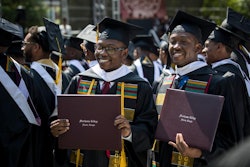It comes as no surprise that some Historically Black Colleges and Universities (HBCUs) are in desperate need. Several recent, high-profile headlines have highlighted the budgetary and enrollment concerns that many HBCUs face.
These issues are so prominent that even the president is paying attention. Recently, many HBCU leaders landed in the Oval Office to express the importance of HBCUs and the challenges they face in the current political and economic landscape. We all remember that awkward photo.
As an HBCU graduate, I know the value of HBCUs. Historically, HBCUs provided an environment for Black students to receive degrees when predominantly White institutions prohibited or admitted only a low number of Black students. The importance of HBCUs cannot be questioned.
While there have been numerous stories publicizing the dwindling number of male students and financial despair of some institutions, a practical solution may be right in front of us. HBCUs already have a key to solve many of their financial and male-enrollment woes to create stability: athletics.
We all know some of the ways college sports can benefit student-athletes: developing and growing leadership qualities and having a well-rounded college experience. They also can provide a sense of community for student-fans of competitive teams. The same rings true for athletics on HBCU campuses. On average, student-athletes account for 8-10 percent of all HBCU students. However, this number spiked to well over 20 percent for some HBCUs and even 40 percent for two HBCUs.
In order to fully utilize athletics to help with financial and enrollment stability, HBCUs should tackle head-on and even embrace what some see as a legal obstacle to expanding men’s athletics – Title IX. Although at first glance it may seem counter-intuitive that a federal regulation focused on providing equal opportunities for female students can be used to increase male enrollment, allow me to explain.
In 1972, Title IX was signed into law. Title IX prohibits discrimination on the basis of sex in any federally funded education program or activity, which includes college athletics. The athletic provisions of Title IX are enforced by the Office for Civil Rights of the Department of Education (“OCR”). There are three parts to Title IX as it applies to athletics programs: (1) effective accommodation of student interests and abilities (participation), (2) athletic financial assistance (scholarships), and (3) equitable treatment components (the “laundry list” of benefits to and treatment of athletes).
OCR evaluates equitable athletic participation opportunities under a test commonly referred to as the “Three Prong Test.” Schools have three alternate ways of demonstrating compliance:
- Prong One: A school complies with Prong One if it provides athletic participation opportunities for male and female students in a ratio substantially proportionate to their full-time undergraduate enrollment ratio.
- Prong Two: A school complies with Prong Two if it demonstrates a history and continuing practice of program expansion demonstrably responsive to the athletic interests and abilities of its underrepresented students (usually female students within an athletics program).
- Prong Three: A school complies with Prong Three if it can demonstrate that its current athletic program fully and effectively accommodates the athletic interests and abilities of its underrepresented students.
As a part of the push for transparent gender equity in athletics, the Equity in Athletics Disclosure Act (EADA) was passed in 1994. The EADA mandates that higher education institutions self-report statistics regarding gender equity in their intercollegiate athletics programs. This database is maintained by the U.S. Department of Education, posted online and readily accessible to the public. The database contains information about each school’s athletics department separated by gender: the number and type of varsity teams, the number of athletes for each team, athletically-related financial aid, coaching staff and salaries, and revenues and expenses. However, it can also expose a school’s Title IX shortcomings.
The 2016-2017 HBCU EADA data reveals that 83 percent of HBCUs have majority female undergraduate populations. For many HBCU campuses, the male to female ratio is 1 to 3. Although male enrollment ratios are low, male students account for the majority of student-athletes at 82 percent of HBCUs. In short, although women represent the majority of the undergraduate population, women receive far fewer athletic participation opportunities than men.
More than 75 percent of HBCUs have an athletics participation gap of 10 percent or more, and nearly half of HBCUs have a gap greater than 20 percent. For perspective, a 2 percent Prong One deviation is typically acceptable, and only 6.7 percent of HBCUs are within this 2-percent range. These numbers demonstrate the hard reality that most HBCUs are too far out of range to obtain Title IX compliance under Prong One, which is not surprising given the large female undergraduate enrollment.
As a result, the majority of HBCUs are exposed to legal complaints that their own publicly-reported numbers suggest they are non-compliant with Title IX.
Prong Two requires expansion of athletic programs to satisfy underrepresented students. This is not a realistic option for many HBCUs because it requires the expenditure of additional financial resources, which is not a luxury enjoyed by many cash-strapped HBCUs. Additionally, this would most likely result in the addition of women’s sports (as the underrepresented gender), which would not aid in many HBCUs’ goal of increasing their male student population.
Thus, the best option for an HBCU to ensure its athletic program is compliant with Title IX and protected from a disruptive OCR investigation is through a proactive Prong Three strategy. A school is considered in compliance with Prong Three unless a sport exists for the underrepresented gender for which all three of the following conditions are met: (1) unmet student interest in a particular sport; (2) sufficient ability to sustain a team in that sport; and (3)a reasonable expectation of competition for a team in that sport.
In essence, Prong Three requires that schools take a proactive approach to Title IX compliance by obtaining feedback from prospective students, current students, coaches and administrators. This information is typically gathered through publicly accessible databases and institution-initiated questionnaires and interviews. While there is always the risk that one can collect “bad” data through questionnaires and interviews suggesting non-compliance, athletic administrators, if in tune with the student body, typically should know if there is unmet athletic interest on campus.
Further, if there is such interest on campus, it is better for administrators to learn about it through proactive efforts and then be able to plan toward it. Often , the Prong Three criteria will not be met, so no obligation to add a particular sport will be triggered. In my experience, many schools have been able to find Title IX compliance through Prong Three and mitigate their legal exposure for possible gender discrimination.
Once a school proactively establishes its compliance with this aspect of Title IX, focus can shift to using the same data to increase male enrollment and financial stability, develop strategic goals and become more competitive both academically and athletically.
Further, once Prong Three compliance is established, the Prong One gap becomes legally irrelevant, so schools are free to consider adding male sports teams to try to drive enrollment and tuition dollars. Given each school’s unique circumstances, deciding which male sports teams to add should be specifically tailored to each school’s needs and interests. For example, while adding football could significantly increase male enrollment and possibly student-fan engagement, it is an extremely expensive start-up sport and, thus, is a viable option only for a small number of HBCUs.
Similarly, Prong Three data may reveal viable club sports or recreational opportunities to better engage with students based on their interests.
HBCUs were established to ensure equality in educational opportunities, and that spirit of equality applies likewise to gender equity in athletics. Regardless of which sport is added, it is important that any new men’s team (or women’s team) is treated equitably with existing teams. As demonstrated above, an athletics department is uniquely positioned to drive enrollment and potentially infuse substantial financial resources into its institution. Therefore, it is imperative that HBCUs ensure their athletic departments are Title IX-compliant so that they can then drive male enrollment and augment the school’s tuition funding. Title IX athletic compliance is not an unattainable goal. It can be accomplished by a team equipped with the knowledge and guidance to implement an organized plan of action. Once Title IX athletic compliance is secured, it can be a critical component in solving the current HBCU financial and male enrollment crises. Therefore, HBCUs should take the time to evaluate their athletic programs, compose a team of Title IX individuals and get to work!
Montoya M. Ho-Sang is a litigation associate in Baker Donelson’s Atlanta office. She represents higher education institutions in the areas of Title IX athletics and sexual misconduct. She also works with colleges and universities drafting policies and procedures and training on a wide range of topics.


















